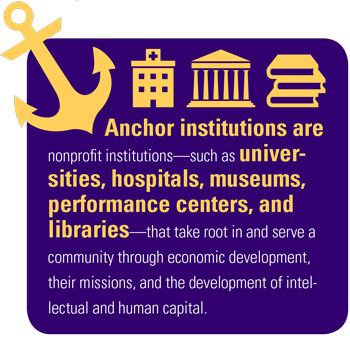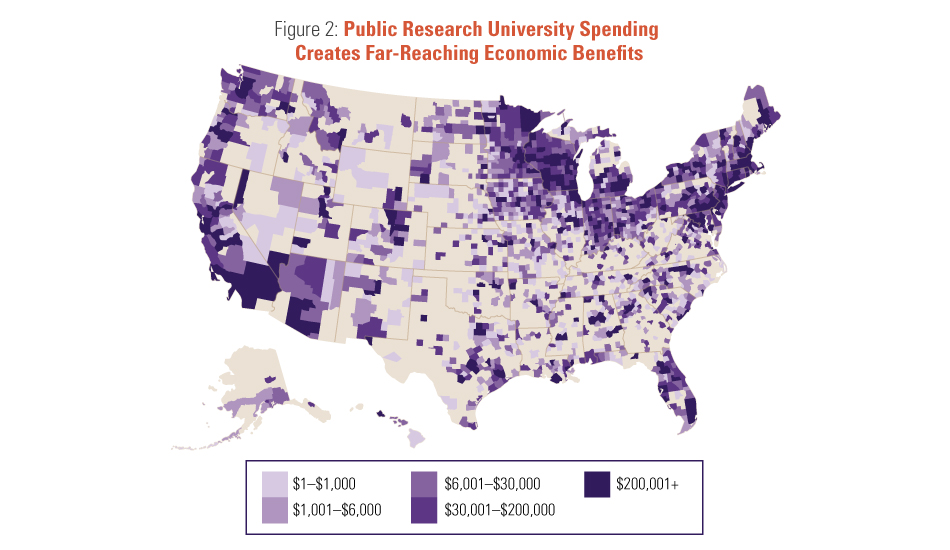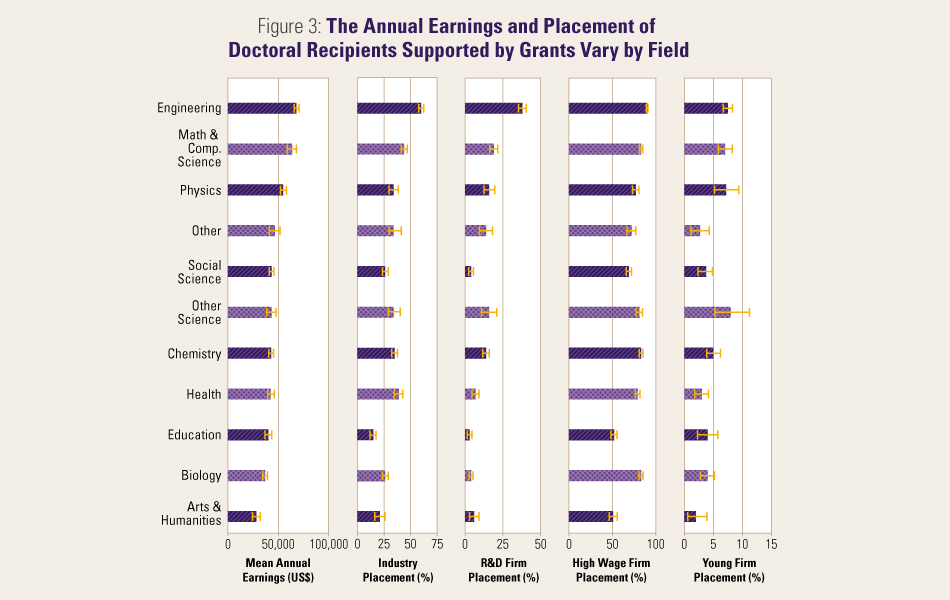Section 2: Public Research Universities Drive Economic Development and Social Well-Being
 Public
research universities are anchors of stability and growth in their regions.
As hubs of research and innovation and as cultural institutions—where concerts,
plays, public lectures, and political debates take place—they are vital to
economic development and the creative economy. Along with other anchor institutions
that, once established, tend to remain in their location and support their immediate
community, universities work with their counties to drive prosperity. Outside of
government, public research universities are often the largest employer in their
state.27
Public
research universities are anchors of stability and growth in their regions.
As hubs of research and innovation and as cultural institutions—where concerts,
plays, public lectures, and political debates take place—they are vital to
economic development and the creative economy. Along with other anchor institutions
that, once established, tend to remain in their location and support their immediate
community, universities work with their counties to drive prosperity. Outside of
government, public research universities are often the largest employer in their
state.27
Midtown Detroit, for example, is being revitalized by its anchor institutions. Wayne State University, the Henry Ford Health System, and the Detroit Medical Center are working together to make Midtown a safe and vibrant place, while maximizing local hiring and investments. These anchor institutions employ thirty thousand local residents and enroll thirty-two thousand students. Each year they hire thirty-three hundred new employees and purchase $1.7 billion in goods and services.28
Fostering New Businesses and EntrepreneurshipThrough knowledge and technology transfer, business incubation and support, community outreach, and the education of about four million students per year, public research universities play myriad roles that together return billions of dollars in revenues.36 Public research universities from twenty-two states were named among the Reuters Top 100 World’s Most Innovative Universities in 2015 that “most reliably produce original research, create useful technology, and have the greatest economic impact.”37 Further, among the top fifty universities in the world at producing venture-capital backed entrepreneurs, twenty are public research universities.38 In 2014, the University of Washington (UW) received $1.4 billion in total sponsored grants and contracts, including $800 million in federal funding. Its Center for Commercialization launched 19 new start-ups, bringing its ten-year total to 103. UW research funding created about 25,960 jobs statewide, and the university generated $12.5 billion in total economic impact in Washington State.39 Graduates of public research universities also go on to build companies in their university’s state: alumni graduating from undergraduate programs at public research universities in the last five years have secured $28.6 billion in venture capital to create 3,458 companies.40 |
Public research universities help meet a critical need for creative goods and services in local economies. One example is Houston, which has a thriving creative economy, estimated at $20.53 billion in a 2012 report. This immense demand for artistic goods and services is met in large part by its anchor institutions. With programs in art theory, architecture, film, theater, dance, and industrial design, the University of Houston is a “training ground” for the creative economic sectors and vital to ensuring that businesses can better meet local demand without having to import talent, goods, and services.29
Public research universities drive innovation districts, in which anchor institutions and companies cluster and connect with start-ups, business incubators, and technology accelerators. These districts also integrate work with housing and recreation. Innovation districts containing public research universities are emerging in cities like Atlanta, Baltimore, Buffalo, Cleveland, Detroit, Houston, Philadelphia, Pittsburgh, St. Louis, and San Diego. Traditional exurban science parks such as Research Triangle Park in Raleigh-Durham, with over two hundred companies and fifty thousand employees, are expanding into a more urbanized environment for their workers.30 North Carolina State’s Centennial Campus houses over 70 partner organizations alongside NC State research centers, their main library, walking trails, game fields, and an 18-hole golf course. This integrated campus facilitates constant interactions among companies, academic researchers, and nonprofit institutions, and has helped launch over 100 startup companies and bring over 400 new products to market.31
The University of Nebraska recently created the Nebraska Innovation Campus next to its main campus in Lincoln to promote knowledge transfer.32 The University of Michigan joined a collaboration of the auto, technology, urban planning, and insurance industries and the local government in creating a thirty-two-acre facility on its north campus called Mcity. At Mcity, partnering organizations combine knowledge and resources to test connected and automated vehicles and transportation systems.33
Public research universities also create and operate incubators to serve the local community and stimulate its economy. TechTown, an incubator at Wayne State University in Detroit, served 1,026 companies from 2007 to 2014, raising more than $107.26 million in startup capital and contributing 1,190 jobs to the local economy.34 In a growing national trend, universities are also developing incubators to foster an entrepreneurial ecosystem on campus. The University of Massachusetts, Dartmouth launched its Center for Innovation and Entrepreneurship in 2001. This incubator has hosted 41 companies on campus, more than a dozen of which have since established their own corporate spaces, and has grown the Massachusetts economy by millions of dollars.35
The Institute for Research on Innovation and Science (IRIS), formed in January 2015 at the University of Michigan, is a national collaborative coordinating efforts around the country to measure the impact of university investment. By linking federal award data to university transactions—including spending and payroll records and U.S. Census Bureau data—IRIS allows researchers to track and analyze information on knowledge transfer, economic impact, and job creation. IRIS’s work is already producing significant results, as illustrated in Figures 2 and 3.

|
The map shows county-level vendor and subcontractor spending for project research sponsored by eight public research university campuses: Ohio State University, Penn State, Purdue, Indiana University, University of Iowa, University of Michigan, University of Minnesota, and University of Wisconsin. Source: IRIS (Institute for Research on Innovation and Science). IRIS PIs include James Evans, University of Chicago; Julia Lane, NYU; Barbara McFadden Allen, CIC (Committee on Institutional Cooperation); Jason Owen-Smith, University of Michigan; and Bruce Weinberg, Ohio State University. Visit http://iris.isr.umich.edu/ for more information. See also Bruce A. Weinberg, Jason Owen-Smith, Rebecca F. Rosen, Lou Schwarz, Barbara McFadden Allen, Roy E. Weiss, and Julia Lane, “Science Funding and Short-Term Economic Activity,” Science 344 (6179) (2014): 41–43.
Vendor Spending and On-Campus Employment
Public research university vendor spending from sponsored research projects is surprisingly widespread and illustrates the broad reach of these institutions as hubs of educational, research, and cultural activities. Between the third quarter of 2013 and the second quarter of 2014, the eight Midwestern universities represented in Figure 2 spent over $1.76 billion on goods and services from vendors in 1,750 counties across the United States. These research projects also paid wages to 70,929 research employees during the same period. Slightly more than 16 percent of the people employed on these grants were faculty members. The remaining 84 percent were professional staff, postdoctoral researchers, and undergraduate and graduate students.41
Employment and Earning Outcomes for Ph.D. Recipients
IRIS and U.S. Census Bureau data suggest that funding for academic research is positively linked to personal and national economic growth. Nearly 40 percent of new Ph.D.s from the eight public research universities studied by IRIS took jobs in industry. Many of those positions were at large and high-wage enterprises operating in high-tech and professional service industries that perform R&D and transmit knowledge from research to the marketplace. Engineers, physicists, and computer scientists were also likely to join young firms that directly facilitate economic growth.42
Table 1: Postgraduation Employment of UMETRICS Doctoral Recipients who were Paid by Research Grants and Left the University between 2009 and 2011
|
|||||||||||||||||||||||||||||||||||||||||||||
Table reproduced with permission. Source: Nikolas Zolas, Nathan Goldschlag, Ron Jarmin, Paula Stephan, Jason Owen-Smith, Rebecca F. Rosen, Barbara McFadden Allen, Bruce A. Weinberg, and Julia I. Lane, “Wrapping It Up in a Person: Examining Employment and Earnings Outcomes for Ph.D. Recipients,” Science 350 (6266) (2015): 1367.

|
Purple bars represent the mean for each variable, and yellow lines (error bars) indicate the standard error. Figure reproduced with permission. Source: Nikolas Zolas, Nathan Goldschlag, Ron Jarmin, Paula Stephan, Jason Owen-Smith, Rebecca F. Rosen, Barbara McFadden Allen, Bruce A. Weinberg, and Julia I. Lane, ”Wrapping It Up in a Person: Examining Employment and Earnings Outcomes for Ph.D. Recipients,“ Science 350 (6266) (2015): 1369.
ENDNOTES
27 National Resource Network, Striking a (Local) Grand Bargain: How Cities and Anchor Institutions Can Work Together to Drive Growth and Prosperity (Washington, D.C.: National Resource Network, 2015), http://www.nationalresourcenetwork.org/en/Document/306220/Striking_a_Local_Grand_Bargain.
28 Initiative for a Competitive Inner City, “Anchor Institutions and Urban Economic Development: From Community Benefit to Shared Value,” Inner City Insights 1 (2) (June 2011): 8–9.
29 “The Creative Economy of Houston: A Comprehensive Study of Creative-Sector Industries and their Impact on the Houston Economy,” commissioned by Houston Arts Alliance and University of Houston in partnership with Greater Houston Partnership, July 2012, http://houstonartsalliance.com/images/uploads/main/Creative_Economy_-_Report_(2012).pdf.
30 See the Research Triangle Park at http://www.rtp.org; and William Fulton, “University Business Parks Model North Carolina State’s Centennial Campus,” Governing, September 2012, http://www.governing.com/columns/eco-engines/col-university-business-parks-model-north-carolina-state.html.
31 North Carolina State University Centennial Campus, https://centennial.ncsu.edu/centennial/; and William Fulton, “University Business Parks Model North Carolina State’s Centennial Campus,” Governing, September 2012, http://www.governing.com/columns/eco-engines/col-university-business-parks-model-north-carolina-state.html
32 See the Nebraska Innovation Campus at http://www.innovate.unl.edu.
33 University of Michigan Mobility Transformation Center, “Mcity Test Facility,” http://www.mtc.umich.edu/test-facility.
34 See TechTown Detroit at http://www.techtowndetroit.org; and Wayne State University, “WSU Economic Development Leader Named TechTown President and CEO,” March 2, 2015, http://wayne.edu/newsroom/release/2015/03/02/wsu-economic-development-leader-named-techtown-president-and-ceo-5544.
35 Kevin P. O’Connor, “UMass Dartmouth renames the ATMC: the Center for Innovation and Entrepreneurship,” Herald News, October 23, 2015, http://www.heraldnews.com/article/20151023/NEWS/151027185.
36 The University of Washington, “Facts FY2014” (updated March 2015), http://www.washington.edu/research/.SITEPARTS/.documents/orFactsheet_2014.pdf.
37 David Ewalt, “The World’s Most Innovative Universities,” Reuters, September 15, 2015, http://www.reuters.com/article/idUSL1N11K16Q20150915.
38 Pitchbook, “Top Universities for VC-backed Entrepreneurs,” in Pitchbook Universities Report, 2015 – 2016 Edition (Seattle: Pitchbook, 2015).
39 The University of Washington, “Facts FY2014.”
40 Pitchbook, “Top Universities for VC-backed Entrepreneurs.”
41 UMETRICS@IRIS, http://iris.isr.umich.edu/ for more information.
42 Nikolas Zolas, Nathan Goldschlag, Ron Jarmin, Paula Stephan, Jason Owen-Smith, Rebecca F. Rosen, Barbara McFadden Allen, Bruce A. Weinberg, and Julia I. Lane, “Wrapping It Up in a Person: Examining Employment and Earnings Outcomes for Ph.D. Recipients,” Science 350 (6266) (2015): 1367. This study uses institutional information from Ohio State University, Penn State, Purdue, Indiana University, University of Iowa, University of Michigan, University of Minnesota, and University of Wisconsin.